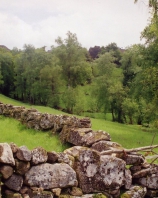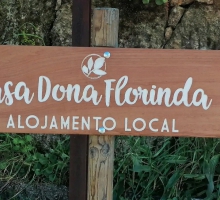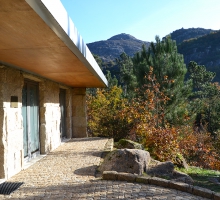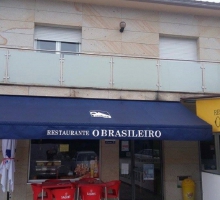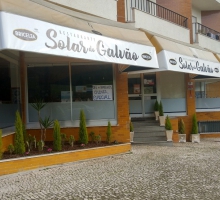The interpretative trail of Serra Amarela runs on both sides of the mountain – it faces river Lima and the municipality of Ponte da Barca by the north side, and River Homem and the reservoir of Vilarinho das Furnas, in the municipality of Terras de Bouro, by the south side – covering about 35 km on footpaths, pavements or stone-pavements. It is a round trail, but due to its length it is recommended to be done by stages.
The Serra Amarela is one of the great reliefs that make part of Peneda Gerês National Park (PGNP), reaching its maximum level in Louriça, 1364 meters altitude. It mainly consists of granite, although there is also a narrow range with schists and greywacke going leaves from the summit of Louriça to north. The climate is cool in summer and severe in winter with high levels of rain, often in form of snow.
The vegetation that can be found in Serra Amarela is conditioned by the climate and geology and also by human occupation. Thus, most of the mountain is covered by dry brushwood dominated by heather, furze and broom. The oaks are more fragmented, however there are still two spots of oaks, one located in the woods of Cabril and the other in the woods of Palheiros, both in a Protected Landscape. Near the peak of Louriça we can find the largest spot of holly (Ilex aquifolium) of Portugal with several big specimens. In terms of fauna we can say that a large part of the 235 species of vertebrates of PGNP can be observed in Serra Amarela. In terms of mammals we can find the ibex (Capra pyrenaica), the roe deer (Capreolus capreolus) and its main predator, the wolf (Canis lupus), protected species considered in danger in Portugal. In terms of birds we can observe many species, although some of the rarer are absent in this area. In terms of herpetology, the horned viper (Vipera latastei) and the gold-striped salamander (Chioglossa lusitanica) are considered vulnerable in Portugal.
This is the biophysical scenery of the ancient and continuous human occupation which began in the Neolithic Period. In these harsh reliefs Man improved land techniques in order to exploit natural resources, in a slow but rational manner, ensuring their survival in a balance between human activity and natural environment. Remains as Serra Amarela Megalithic Necropolis and “Bouça do Calado” Shrine; remains from the Roman Period such as the small parishes of “Cabeço de Leijó” and “Torre Grande”; Medieval remains as “Castelo do Lindoso” and several “brandas” and other ancient small parishes mainly from the medieval epoch, populate the Serra Amarela and take us back to a world we do not know but we are able to imagine. We can admire, through this vast cultural heritage, the courage of the communities to establish and survive in this scenery from the Neolithic to the present days.
Location: Ponte da Barca
The Serra Amarela is one of the great reliefs that make part of Peneda Gerês National Park (PGNP), reaching its maximum level in Louriça, 1364 meters altitude. It mainly consists of granite, although there is also a narrow range with schists and greywacke going leaves from the summit of Louriça to north. The climate is cool in summer and severe in winter with high levels of rain, often in form of snow.
The vegetation that can be found in Serra Amarela is conditioned by the climate and geology and also by human occupation. Thus, most of the mountain is covered by dry brushwood dominated by heather, furze and broom. The oaks are more fragmented, however there are still two spots of oaks, one located in the woods of Cabril and the other in the woods of Palheiros, both in a Protected Landscape. Near the peak of Louriça we can find the largest spot of holly (Ilex aquifolium) of Portugal with several big specimens. In terms of fauna we can say that a large part of the 235 species of vertebrates of PGNP can be observed in Serra Amarela. In terms of mammals we can find the ibex (Capra pyrenaica), the roe deer (Capreolus capreolus) and its main predator, the wolf (Canis lupus), protected species considered in danger in Portugal. In terms of birds we can observe many species, although some of the rarer are absent in this area. In terms of herpetology, the horned viper (Vipera latastei) and the gold-striped salamander (Chioglossa lusitanica) are considered vulnerable in Portugal.
This is the biophysical scenery of the ancient and continuous human occupation which began in the Neolithic Period. In these harsh reliefs Man improved land techniques in order to exploit natural resources, in a slow but rational manner, ensuring their survival in a balance between human activity and natural environment. Remains as Serra Amarela Megalithic Necropolis and “Bouça do Calado” Shrine; remains from the Roman Period such as the small parishes of “Cabeço de Leijó” and “Torre Grande”; Medieval remains as “Castelo do Lindoso” and several “brandas” and other ancient small parishes mainly from the medieval epoch, populate the Serra Amarela and take us back to a world we do not know but we are able to imagine. We can admire, through this vast cultural heritage, the courage of the communities to establish and survive in this scenery from the Neolithic to the present days.
Location: Ponte da Barca
